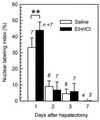Ethanolamine modulates the rate of rat hepatocyte proliferation in vitro and in vivo
- PMID: 9207089
- PMCID: PMC23819
- DOI: 10.1073/pnas.94.14.7320
Ethanolamine modulates the rate of rat hepatocyte proliferation in vitro and in vivo
Abstract
A low molecular weight, heat-resistant hepatotrophic factor in an extract from the bovine intestinal mucosa was purified and identified as ethanolamine by structural analyses. The mode of action of ethanolamine in vitro and in vivo coincided with that of the crude extract of the tissue, indicating that ethanolamine is the active component. Ethanolamine synergistically elevated the stimulation of DNA synthesis in hepatocytes in primary culture when added together with a growth factor, such as epidermal growth factor, with the ED50 being 20 microM, although it showed little stimulatory effect by itself. Contrary to these in vitro results, the intraperitoneal administration of ethanolamine hydrochloride (24 mg of ethanolamine per kg of body weight) enhanced hepatocyte proliferation in regenerating rat livers after two-thirds hepatectomy without the administration of any growth factors. In the regenerating liver, hepatocyte proliferation may be initiated by an endogenous growth factor, but the supply of ethanolamine in circulation may not be sufficient for optimal hepatocyte proliferation; thus, the exogenous administration of ethanolamine may further enhance hepatocyte proliferation. Ethanolamine in circulation may be a humoral hepatotrophic factor.
Figures





References
-
- Sasaki, H., Nemoto, A., Kume, H., Narisawa, S. & Takahashi, N. (1997) In Vitro Cell. Dev. Biol. Anim., in press. - PubMed
-
- Takahashi N, Kumanaka H, Takagi H, Mori N. In Vitro Cell Dev Biol. 1989;25:365–372. - PubMed
-
- Heinrikson R L, Meredith S S. Anal Biochem. 1984;136:65–74. - PubMed
-
- Tsao M C, Walthal B J, Ham R G. J Cell Physiol. 1982;110:219–229. - PubMed
MeSH terms
Substances
LinkOut - more resources
Full Text Sources
Other Literature Sources

